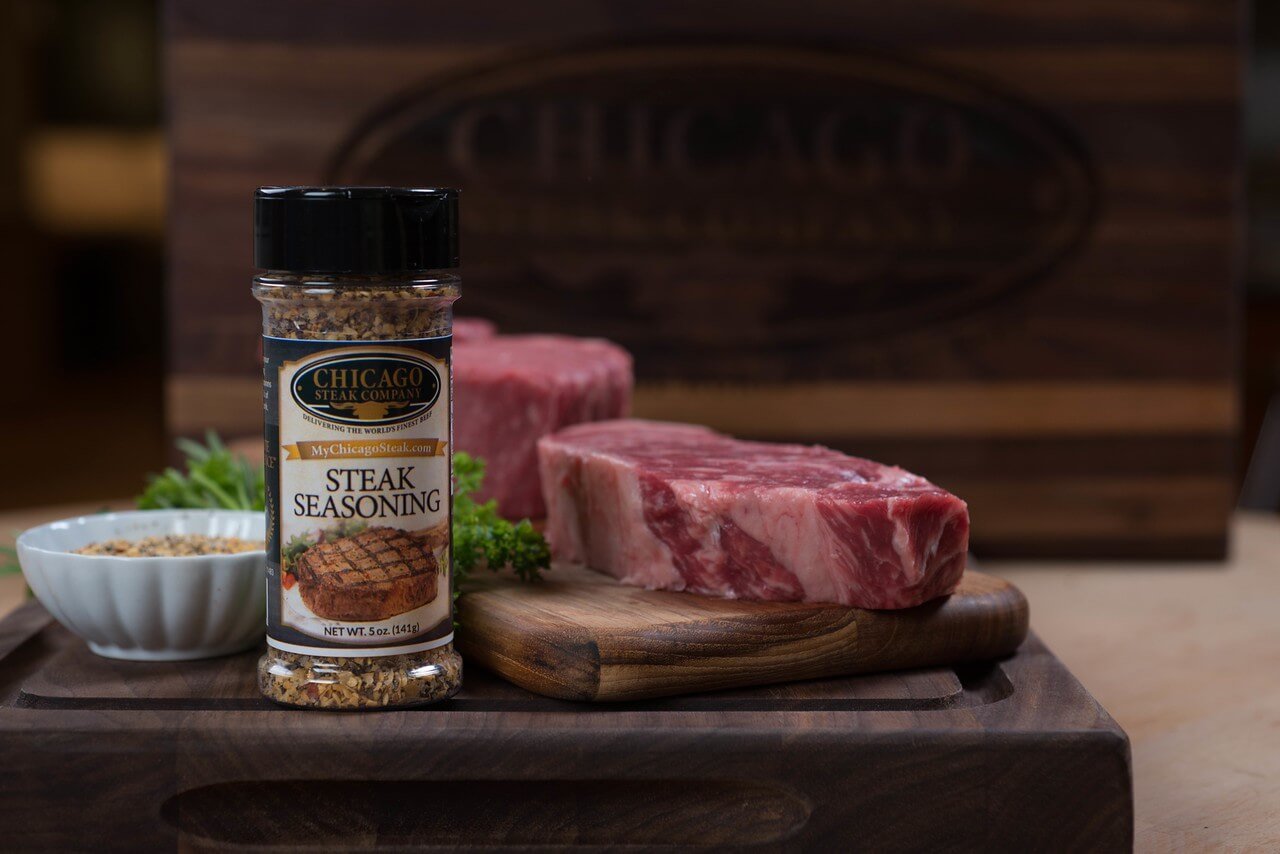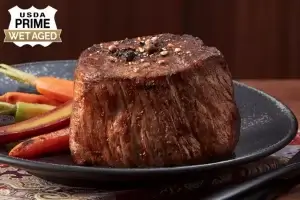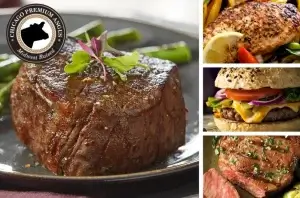
While high-end steaks usually ask for minimal seasonings, the perfect dry rub or marinade can elevate your steak to an entirely new level. Now, in Part II of our intro into seasoning and flavor, we explore what an interplay of flavors can do for your steak.
In Part I, we covered three salt-rich methods for adding steak flavor and, in some cases, tenderness: straight salting, dry brining, and wet brining.
In Part II, we’re going to tackle, bigger, bolder, more complicated flavors. We’ll start with spice rubs, move on to marinades, and finish up with the backyard-carnivore’s best-kept secret: meat injection (not as weird as it sounds, we promise!).
Table of Contents
Steak Rubs 101
- What Rubs Are: The name “rub” can be a bit misleading, as most people think of dry rubs when they think of rubs for steaks or other meats. Rubs, however, can include oil or butter (these are called wet rubs). All that matters is that rubs contain different spices or herbs and are rubbed directly onto a piece of meat’s surface.
- What Rubs Do: Rubs bring flavor, plain and simple. While rubs that include salt can have a deeper effect on meat, most experienced chefs suggest keeping salt out of your rub, then salting your meat later, right before cooking. Spices with sugar in them, meanwhile, can help with the browning of your steak.
- How To Use Rubs On Steaks: Some people insist you should not actually rub spice rubs (or other kinds of rubs) into your meat. These people will say you can squeeze precious juices out of your steak, pork chop, or chicken cutlet. They’re wrong. Meat’s a lot more resilient than they think – so rub away.
- How Rubs Works: For most rubs, the effect on steak is primarily one of surface flavor. Spices and herbs interact with steak juices as cooking happens, producing new, unique flavors and flavor interplay.
Most professional and amateur chefs will tell you straight away to avoid any store-bought dry rubs. These are often high in salt, and superior homemade rubs can be made cheaply in the comfort of your kitchen.
Finding the right rub is a process of discovery. There are many reasons for this. First, the flavor of cooked spices, herbs, sugars, and oils is often vastly different from their flavor when raw. Second, the interplay of one spice or herb with another or with a piece of meat is often completely unique. Third, your cupboard is likely filled with various dry spices and herbs, never mind the fresh ones you can pick up from the local fruit market or grocery store.
Our suggestion is to make your own rubs, starting out with recipes found online (if it sounds delicious, try it). The more familiar you get with different spices and herbs, the more you’ll be able to experiment.
One property of certain rubs is the way they encourage the Maillard reaction (what gives your steak its crunchy, brown crust). As we covered in Part I with wet brines, sugar can the ability to speed up this process. Because of this, many steak rub recipes call for a small amount of brown sugar.
When To Use Rubs On A Steak: The great thing about rubs is their flexibility. So long as they are used with dry heat, rubs are a great way to give a steak kick or a bold new flavor.
Marinading Steak 101
- What is Marinating: Marinating is a similar process to brining. Meat is submerged in a bath of flavorful liquid before cooking. This liquid often contains juices or acids, as well as oils, herbs, and spices.
- What Marinating Does: Marinating gives steak greater flavor and helps to tenderize meat. There is a misconception that marinating – like brining – permeates meat with flavor, but this is not true. Marinating only has a major effect on a piece of meat’s surface, and rarely permeates or tenderizes more than an eighth of an inch deep.
- How To Marinate Your Steak: Marinades are built around flavorful, tenderizing liquids. Think acids, such as lemon juice, wine, or vinegar, or fruit juices whose chemical makeup tenderizes meat, such as papaya juice or pineapple juice. After that, you add whichever oils, sugars, spices, or aromatics you think best. As with rubs, the oils, sugars, spices, and herbs you use can take years of getting to know. We suggest starting out with tasty-sounding recipes, then experimenting as you get more familiar.
- How Marinating Works: The tenderizing process for marinades works through acids and naturally occurring enzymes. These break down the tough connective tissues in meat, resulting in an easier-to-chew cut of beef. Unlike salt solutions, however, which loosen muscle fibers and seep into meat, marinades stay mainly on meat’s surface. As with wet brining and rubs, a sugary marinade can help promote the Maillard reaction and browning.
- When To Marinate A Steak: If you are only looking for flavor, marinating can be a perfect way to imbue the outer layer of your meat with delicious new tastes. If you are looking to tenderize a tougher cut, however, marinating will only tenderize the meat’s outer surface. Rely on brine, brinerade (a brine/marinade crossover) or meat injection if you want to flavor and tenderize thicker cuts of meat, and use marinade for thinner, tougher cuts, such as short ribs.
One tip to increase the impact of your marinade is to score, or “gash,” your meat before-hand. Despite what some people will tell you, this does not cause juices to leak (a cut of meat is literally cut to begin with). Instead, what it does is create more surface area for the marinade to interact with.
Meat Injection 101
- What Injection Is: Meat injection involves using a meat injector – which looks like an oversized hypodermic needle – to inject butter, broth, sauces, marinades, and other liquid seasonings directly into a cut of meat
- What Injection Does: Meat injection is an excellent way to add flavor, tenderness, and juiciness to big, thick cuts of meat, and to overcome marinating’s failure to penetrate meat’s surface.
- How To Inject Your Steak: Injection starts with a high quality meat injector. Injectors look like large, metal hypodermic needles, and usually come in 2 or 4 ounce sizes.
- How Injection Works: The science behind injection is pretty simple – if flavor won’t go where you want it to go on its own (i.e. to the centre of your brisket), then force it there by injecting it directly.
- When To Inject A Steak: Injection can add flavor to just about any cut of meat, and has been a secret weapon for barbecue fans and grillmasters for some time. Meats that benefit most from injection tend to be thicker, tougher cuts.
You then draw your liquid of choice into the injector, push the injector’s needle into the middle of your meat, and then press down on the plunger (or, depending on your injector, pull the trigger).
It is important, especially with larger cuts, that you inject throughout the cut of meat (in more than one spot) so that the liquid is spread throughout your steak.
The great thing about injection is that your meat retains the liquid you inject, resulting in a plumper, juicier cut of meat. Injection also allows the acids and enzymes in marinades to spread throughout your steak, giving it tenderness from surface-to-center.
Discover Steak Flavor!
Now that you’re familiar with the best ways to enhance beef’s flavor before steak meets flame, it’s time to get cooking. Why not check out Steak U’s guide to steak cooking techniques, to find the method best for your steak.



